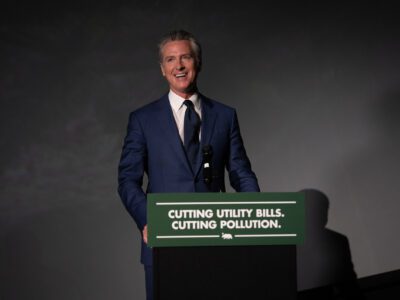2021-2022 California Environmental Legislation: What’s Been Enacted?
Climate change and heat bills have been signed in two packages amidst other environmental legislation at the end of the 2021-2022 legislative session.
At the close of California’s legislative session on September 1, legislators sent a number of environmental bills to the Governor for his signature, including measures to mitigate climate change, cope with extreme heat, advance the state’s clean energy goals, deal with California’s ongoing drought, decarbonize buildings, build more transit-friendly affordable housing, and conserve our natural lands. Now that September is over—and the Governor’s window to sign or veto legislation has closed—this post will provide a roundup of key environmental laws that passed at the end of this session, although the bills discussed below are only some of the many environmental bills that have become law this year (including SB 54, landmark plastic waste legislation that was signed earlier in 2022).
Climate Change Mitigation
The Governor approved a notable slate of climate legislation with a package that includes more stringent greenhouse gas (GHG) emission targets and measures designed to reduce the state’s reliance on fossil fuels. In signing these bills, the Governor touted the state as the most aggressive actor on climate in the nation. Implementation of these new laws will be the true test of that statement, but they provide an exciting starting point.
Critically, AB 1279 updates California’s statewide carbon neutrality goal to achieve net zero greenhouse gas emissions by no later than 2045, and codifies a separate goal of achieving GHG emission reductions to at least 85% below the state’s 1990 levels by 2045. Prior to this new law, the state was required by law to ensure that statewide greenhouse gas emissions be reduced to at least 40% below the 1990 level by 2030. The ambitious new target will require much more drastic reduction tactics across all sectors of California’s economy.
To meet these goals, the state is facilitating burgeoning carbon capture and sequestration (or storage) (CCS) technologies that capture carbon from point sources to store, as well as carbon dioxide removal (CDR), which removes carbon from the atmosphere. SB 905, which passed contingent upon the Legislature’s passage of the net zero and GHG reduction targets in AB 1279, requires the California Air Resources Board (CARB) to establish a Carbon Capture, Removal, Utilization, and Storage Program to evaluate these technologies and adopt a clear regulatory framework for their construction and operation. And to address one environmental justice concern with the program, SB 1314 prevents the carbon produced by these projects from being reinjected into wells for enhanced oil recovery, although other environmental justice concerns such as the permanence of and leakage from storage or the incentivization of continued fossil fuel reliance will need to be addressed.
On the other hand, one tangible breakthrough carbon reduction and environmental justice success has been the culmination of campaigns at the state and local level to protect communities from the harmful impacts of oil and gas wells with a setback. In the past several years, UCLA law students from both our Frank G. Wells Environmental Law Clinic and our California Environmental Legislation and Policy Clinic have been involved in these efforts. Now, SB 1137 protects communities by establishing a setback distance of 3,200 feet for homes, schools, parks, or businesses open to the public from new wells, and requires comprehensive pollution controls for existing oil wells within the setback zone.
Other new climate-related legislation includes the following:
- SB 45 facilitates local action on short-lived climate pollutants by requiring CARB and CalRecycle to assist local jurisdictions in complying with the state’s existing short-lived climate pollutant strategy.
- SB 1145 requires CARB to create and maintain an online dashboard providing the public with information about the state’s progress on meeting its climate change goals, increasing government accountability.
- AB 1757 promotes natural carbon capture by requiring the state to develop targets for natural carbon sequestration and nature-based climate solutions that reduce GHGs in support of its climate goals.
- AB 2101 expands carbon sequestration projects to include whole orchard recycling (onsite grinding or chipping of whole trees during orchard removal for use in topsoil).
Heat
The Governor also signed a package of heat bills to address the deadly extreme heat that has been plaguing the state. AB 2238 creates the nation’s first extreme heat advance warning and ranking system. The system will be based on data on weather and climate such as duration of extreme heat events, science on and records of the health impacts of heat, heat severity measurements, local information, and public comments, among other factors. The hope is that the warning and ranking systems will better enable communities to prepare for heat waves, particularly those that are disproportionately affected by extreme heat. In addition to this statewide system, SB 852 authorizes cities and counties to form climate resilience districts to finance extreme heat, drought, wildfire, and other climate resilience programs, empowering local governments to address these issues on a regional level.
AB 2243, which was developed through a partnership between students in UCLA’s California Environmental Legislation and Policy Clinic and Assemblymember Eduardo Garcia’s office, addresses heat and air quality impacts on agricultural workers. The law mandates availability of protective equipment during poor air quality events, and directs Cal/OSHA, the state’s labor regulator, to consider additional high heat protections.
Other heat-related legislation includes the following:
- AB 1643 creates an advisory committee to study the effects of extreme heat on workers, business, and the economy.
- AB 2420 lays the groundwork for alleviating the health impacts of extreme heat for perinatal and infant children. It requires the Department of Public Health to review literature on adverse effects of extreme heat on perinatal health to develop guidance for safe conditions and health considerations for pregnant individuals and infant children.
- SB 896 mitigates wildfire risk, which often correlates to extreme heat events, by requiring local assessments of the defensible space of buildings or structures in very high and high fire severity zones.
Clean Energy
As the state transitions off fossil fuels, the importance of building a reliable and robust clean energy grid continues to increase. SB 1020 signals the state’s continued prioritization of clean energy development, adding to the state’s existing goal for 100% clean electricity retail sale by 2045 by establishing interim clean energy targets of 90% of all retail electricity sales be renewable and zero-carbon by 2035 and 95% by 2040.
The Legislature also passed two budget trailer bills, AB 205 and AB 209, to provide financial resources to effectuate the state’s clean energy goals. The two bills allocate funding for utility customer debt relief; long duration energy storage projects to increase grid electricity capacity; increases in energy supply and preventing outages; decarbonization of buildings, the industrial sector, and the food sector; and renewable hydrogen production and direct air capture programs. They also adopt policies such as enabling utility residential rates based on customers’ ability to pay; streamlining the certification process for renewables like solar, wind, or geothermal energy generation; updating the building code to incentivize ultra-low-global warming potential refrigerants; and ensuring homes maintain a maximum safe indoor air temperature.
Other clean energy bills that became law include three authored by Senator Hertzberg: SB 529, which expedites review and approvals for transmission upgrades and construction; SB 1174, which directs state agencies to identify and advance necessary interconnections or transmissions for clean energy; and SB 1340, which incentivizes solar energy by extending an existing property tax exclusion for newly constructed and active solar energy systems. And legislation to support sustainable transportation passed, including: SB 1226, which allows agencies to form Joint Powers Authorities to further zero-emission transportation and public transit goals, and SB 1305, which requires the state to maximize the purchase and availability of alternative fuel vehicles for its own vehicle fleet.
Success on sustainable transportation did not extend to the realm of air travel: AB 1322, which would have set a sustainable fuels target for the aviation sector, was vetoed. Newsom pointed to the state’s existing Low Carbon Fuel Standard program as an alternative to the bill, although aviation fuel producers may choose not to opt-into the program, limiting its efficacy.
Water
California continues to confront an extreme drought that is not predicted to end this year, and even if rain were to fall one season of water would be inadequate to escape the state’s water troubles. Lawmakers have accordingly sought ways to conserve water, particularly in urban areas. To incentivize efficient water use, SB 1157 reduces the cap for indoor residential water use from 55 gallons per capita daily to 47 gallons per capita daily and requires the state to assess the impacts of the indoor residential use standard on water, wastewater, and recycled water systems. AB 2142 also seeks to stretch water by incentivizing homeowners to replace lawns with drought-tolerant landscaping, although this will only make a small dent in overall consumption given that urban sectors use just 10% of the state’s water supply compared to agriculture’s use of 40%.
New laws also address water access for tribal communities, which are uniquely impacted by the drought. AB 2877 facilitates tribal access to the Safe and Affordable Drinking Water Fund without jeopardizing tribal sovereignty. AB 2108 requires the State and Regional Water Boards to conduct environmental justice outreach regarding disproportionate impacts to water quality from waste discharge in disadvantaged communities or tribal communities. AB 2108 also requires findings on potential environmental justice, tribal impact, and racial equity considerations when adopting water quality control plans or state policies for water quality control.
Other water-related legislation includes the following:
- SB 1188 facilitates financial assistance for public water systems through the existing the Safe Drinking Water State Revolving Fund Law.
- SB 1205 protects water access by requiring the state to develop regulations considering climate change effects on water availability for water rights permits.
- AB 1811 mitigates flood risk by requiring local agencies to include planning for climate change, rainwater, and stormwater management in local flood protection plans.
- AB 1832 protects tidal waters by prohibiting permits for the extraction or removal of hard minerals from state waters subject to tidal influence, with exceptions.
- SB 891 closes a loophole in existing law to bring businesses into compliance with stormwater permitting requirements.
- SB 230 requires the state to study constituents of emerging concern in waters of the state and drinking water.
Land Use and Building Decarbonization
The Governor signed notable new laws designed to address the housing affordability crisis, with GHG reduction co-benefits. SB 6 and AB 2011 enable residential development in zones where office, retail, or parking are a principally permitted use. AB 2011also exempts the approval of certain affordable housing projects from CEQA, streamlining the permit process and encouraging urban densification. AB 2097 prohibits minimum parking requirements on any project within half a mile of public transit. This encourages increased use of public transportation, to better take advantage of the benefits of urban density.
Of course, buildings themselves can be big carbon emitters, and are responsible for a quarter of California’s GHG emissions. Two new laws address this issue on different fronts. AB 2446 requires reductions of average carbon intensity in construction materials for new buildings and also sets comprehensive targets to achieve a net 40% reduction from 2026 building material GHG emission levels by 2035. SB 1206 limits the sale of short-lived climate pollutants that are exponentially more potent than carbon dioxide like hydrofluorocarbons, commonly used in refrigeration, air conditioning, building insulation, and more.
Ecological Conservation
This year saw significant budget allocations to facilitate California’s conservation goals. The natural resources trailer bill, SB 155, allocates $768 million from the budget for multi-benefit and nature-based solutions, including those supporting the state’s 30 by 30 goal to conserve 30% of lands and coastal waters by 2030; as well as $500 million for protection and restoration for coastal and ocean resources from sea level rise and climate change.
A Few Notable Vetoes
While the Governor signed a number of significant environmental laws, he also vetoed several, including laws intended to address impacts to low-income communities of color from air pollution, water pollution, and sea level rise.
- AB 2550 would have required CARB to take extra steps to supervise the San Joaquin Valley Air Pollution Control District and engage with affected communities in the Valley in light of the District’s failure to achieve attainment of national ambient air quality standards. While the Governor’s veto message asserted that additional legislative direction was not necessary, communities in the Valley continue to suffer from serious air pollution.
- Citing cost concerns, the Governor vetoed AB 2248, which would have made funding available to address water quality problems in California-Mexico cross-border rivers. Such rivers include the New River and the Tijuana River, which are heavily polluted—New River is one of the most polluted in the nation and imperils residents in Imperial County.
- Calling for more comprehensive frameworks to address sea level rise, the Governor vetoed SB 1078, an innovative bill to address sea level rise through a revolving loan fund that would have financed a local government buy-leaseback program for properties at long-term risk from rising seas.
Conclusion
The end of the 2021-2022 Legislative Session saw notable legislation on climate, heat, clean energy, water, and land use become law. While this most recent wave of legislation advances progress toward the state’s environmental goals, California requires continued and ambitious action in the fight against climate change.







Reader Comments